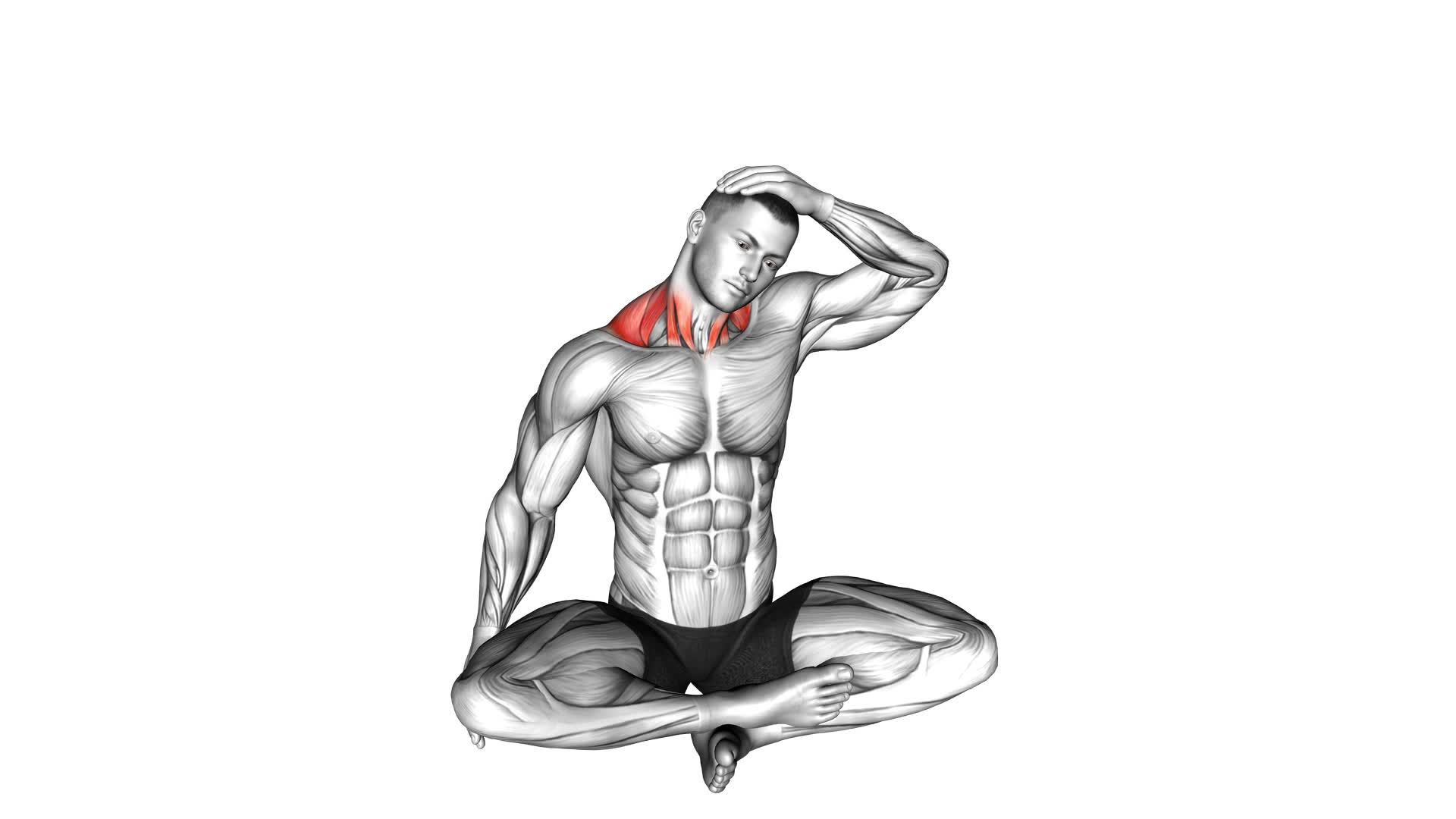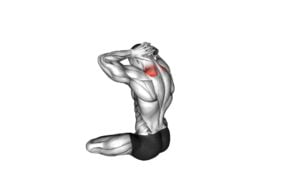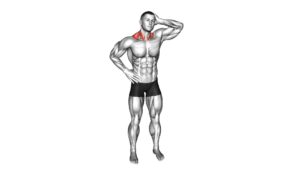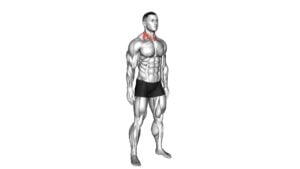Seated Neck Side Stretch – Video Exercise Guide & Tips

Are you looking for a quick and effective way to relieve tension in your neck? Look no further than the seated neck side stretch.
Watch This Exercise Video
In this video exercise guide, we will show you how to properly perform this stretch for maximum benefits. Avoid common mistakes and learn variations and modifications to suit your needs.
Incorporate the seated neck side stretch into your routine and say goodbye to neck discomfort.
Let's get started!
Key Takeaways
- The seated neck side stretch promotes neck flexibility and relieves tension in the neck and upper back muscles.
- Proper form and technique include sitting in a comfortable position, keeping the spine straight and shoulders relaxed, and avoiding sudden movements or jerking motions.
- Common mistakes to avoid during this stretch include straining or forcing the stretch, neglecting to engage core muscles, and pulling the head or neck too far to the side.
- Variations and modifications of the seated neck side stretch include alternative stretches, adaptations for different fitness levels, intensifying the stretch with hand assistance, incorporating props like a yoga block or towel, and targeting different muscles for added variety.
Benefits of the Seated Neck Side Stretch
Discover the numerous benefits of performing the Seated Neck Side Stretch. This stretching technique is highly effective in promoting neck flexibility and relieving tension in the neck and upper back muscles. By incorporating this stretch into your regular exercise routine, you can improve your overall health and well-being.
One of the health benefits of the Seated Neck Side Stretch is improved posture. Many people spend hours sitting at a desk or hunched over electronic devices, which can lead to poor posture and neck pain. This stretch helps to lengthen and strengthen the neck muscles, allowing for better alignment of the spine and improved posture.
Additionally, this stretch can help to reduce headaches and migraines. Tension in the neck and upper back muscles can often contribute to headaches. By performing the Seated Neck Side Stretch, you can release tension in these muscles and alleviate headaches.
Furthermore, this stretch can also improve circulation to the neck and head. As you stretch the neck muscles, blood flow to the area increases, providing more oxygen and nutrients to the tissues. This can help to improve overall brain function and cognitive performance.
Proper Form and Technique
To perform the Seated Neck Side Stretch with proper form and technique, position yourself in a comfortable seated position. Sit up tall and ensure that your spine is straight. Relax your shoulders and keep them down, away from your ears.
Take a deep breath in and as you exhale, gently tilt your head towards one shoulder, keeping the opposite shoulder grounded. You should feel a stretch on the side of your neck. Hold this position for 15 to 30 seconds, breathing deeply throughout.
Remember to avoid any sudden movements or jerking motions. Repeat on the other side.
Proper form and technique are crucial when performing the Seated Neck Side Stretch to reap its benefits safely. This exercise helps to improve flexibility in the neck and shoulders, relieve tension, and reduce the risk of muscle imbalances and stiffness.
By maintaining a comfortable seated position and practicing slow, controlled movements, you can ensure that you're targeting the right muscles and avoiding any strain or injury. It's important to listen to your body and not push beyond your limitations.
If you experience any pain or discomfort, stop the exercise immediately and consult with a healthcare professional. Regular practice of the Seated Neck Side Stretch with proper form and technique can contribute to better posture and overall neck health.
Common Mistakes to Avoid
Avoid these common mistakes when performing the Seated Neck Side Stretch to ensure proper alignment and maximize the benefits of this exercise. One common mistake is straining or forcing the stretch by pulling the head or neck too far to the side. Remember to perform the stretch with control and only go as far as is comfortable for you.
Another mistake is neglecting to engage the core muscles while performing the stretch. Your core muscles play a crucial role in maintaining stability and proper alignment. Be sure to keep your core engaged throughout the exercise to prevent unnecessary strain on the neck and shoulders.
Additionally, avoid hunching the shoulders or rounding the upper back during the stretch. Instead, focus on keeping the shoulders relaxed and down, and maintaining a tall and upright posture.
By avoiding these common mistakes and maintaining proper alignment, you can safely and effectively perform the Seated Neck Side Stretch.
Now, let's move on to the next section to explore variations and modifications of this exercise.
Variations and Modifications
You can make variations and modifications to the Seated Neck Side Stretch to target different muscles and add variety to your stretching routine. Here are some options to consider:
- Alternative stretches: If the Seated Neck Side Stretch doesn't feel comfortable or effective for you, there are alternative stretches you can try. For example, you can perform a standing neck stretch by tilting your head to one side and gently pulling it with your hand. Another option is the lying down neck stretch, where you lie flat on your back and let your head fall to one side, using your hand to apply gentle pressure.
- Adaptations for different fitness levels: If you're a beginner or have limited flexibility, you can modify the Seated Neck Side Stretch by only tilting your head to a comfortable range of motion. As you become more flexible, you can gradually increase the range of motion and hold the stretch for longer durations. Additionally, for those with advanced flexibility, you can intensify the stretch by using your hand to gently pull your head further into the stretch.
- Incorporating props: To enhance the effectiveness of the Seated Neck Side Stretch, you can use props such as a yoga block or towel. Placing a block or rolled-up towel between your head and the hand you're using to stretch can provide support and increase the stretch's intensity.
Tips for Incorporating the Seated Neck Side Stretch Into Your Routine
To incorporate the Seated Neck Side Stretch into your routine, consider these helpful tips.
Neck stretches can be an effective way to relieve neck pain and improve flexibility.
First, find a quiet and comfortable space where you can focus on your stretching routine.
Sit in a chair with your feet flat on the ground and your back straight.
Start by gently tilting your head to one side, bringing your ear towards your shoulder.
Hold this position for 15-30 seconds, feeling a stretch along the side of your neck.
Remember to breathe deeply and relax your shoulders throughout the stretch.
Repeat on the other side.
As you become more comfortable with the stretch, you can increase the intensity by gently pulling your head towards the opposite shoulder with your hand. However, be cautious not to overstretch or cause any pain.
It's important to listen to your body and stop if you feel any discomfort.
Incorporating the Seated Neck Side Stretch into your routine can help alleviate neck pain and improve your overall well-being.
Frequently Asked Questions
Can the Seated Neck Side Stretch Help With Relieving Tension Headaches?
Yes, the seated neck side stretch can be helpful in relieving tension headaches.
By gently stretching the muscles in your neck, this exercise can help release tension and reduce headache pain.
It targets specific areas that often hold tension, providing relief and promoting relaxation.
Incorporating neck stretches like the seated neck side stretch into your routine can be an effective way to alleviate tension headaches and improve overall neck health.
Is It Safe to Perform the Seated Neck Side Stretch if I Have a Neck Injury or Condition?
If you have a neck injury or condition, it's important to consider the safety of performing the seated neck side stretch. Consulting with a healthcare professional is crucial in determining whether this exercise is appropriate for you.
They can evaluate your specific situation and provide tailored advice to ensure your safety. It's always better to be cautious and seek professional guidance to prevent further harm or aggravation to your neck injury or condition.
How Long Should I Hold the Stretch for Optimal Results?
To get optimal results from the seated neck side stretch, it's important to hold the stretch for the right duration. The duration of the stretch depends on your stretching technique and your comfort level.
It's generally recommended to hold the stretch for about 20 to 30 seconds on each side. This allows your muscles to lengthen and relax, promoting flexibility and relieving tension in the neck.
Remember to listen to your body and adjust the duration as needed.
Can the Seated Neck Side Stretch Improve Posture?
The seated neck side stretch is a great exercise for improving flexibility and preventing neck pain. By regularly performing this stretch, you can help improve your posture.
It targets the muscles in your neck and upper back, which play a key role in maintaining good posture. This stretch can help alleviate tension and tightness in these muscles, allowing you to sit and stand taller.
Incorporating the seated neck side stretch into your routine can have a positive impact on your overall posture.
Can the Seated Neck Side Stretch Be Done While Sitting at a Desk or in a Chair?
Yes, the seated neck side stretch can be done while sitting at a desk or in a chair. It's a great exercise to improve your desk posture and relieve tension in your neck and shoulders.
Conclusion
Incorporating the seated neck side stretch into your routine can provide numerous benefits, such as relieving tension and improving flexibility in the neck and upper back.
By maintaining proper form and technique, avoiding common mistakes, and exploring variations and modifications, you can effectively target different areas of the neck and cater to your specific needs.
Remember to consult with a healthcare professional before starting any new exercise routine.

Author
Years ago, the spark of my life’s passion ignited in my mind the moment I stepped into the local gym for the first time. The inaugural bead of perspiration, the initial endeavor, the very first surge of endorphins, and a sense of pride that washed over me post-workout marked the beginning of my deep-seated interest in strength sports, fitness, and sports nutrition. This very curiosity blossomed rapidly into a profound fascination, propelling me to earn a Master’s degree in Physical Education from the Academy of Physical Education in Krakow, followed by a Sports Manager diploma from the Jagiellonian University. My journey of growth led me to gain more specialized qualifications, such as being a certified personal trainer with a focus on sports dietetics, a lifeguard, and an instructor for wellness and corrective gymnastics. Theoretical knowledge paired seamlessly with practical experience, reinforcing my belief that the transformation of individuals under my guidance was also a reflection of my personal growth. This belief holds true even today. Each day, I strive to push the boundaries and explore new realms. These realms gently elevate me to greater heights. The unique combination of passion for my field and the continuous quest for growth fuels my drive to break new ground.







